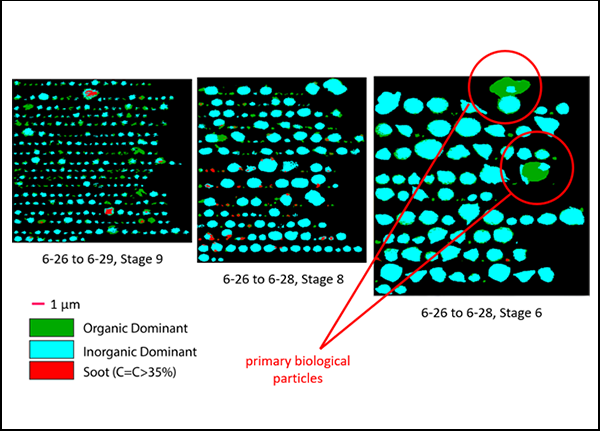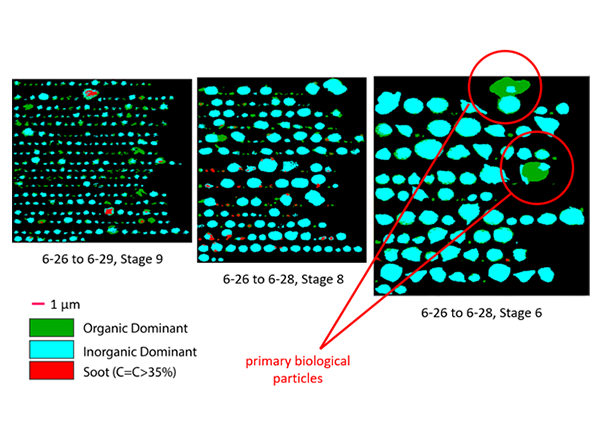Spectro-Microscopic Investigations of the Aerosol Impact on Climate
Clients
Purdue University
U.S. Department of Energy (DOE) Atmospheric Systems Research (ASR) Program
Airborne particles, such as aerosols, influence global climate in many ways, including atmospherically and by depositing onto the earth’s surface. Sonoma Technology is working with Purdue University researchers to better understand how particles affect Earth’s climate system. Our work, supported by the DOE’s <a href="https://asr.science.energy.gov/" target="_blank">ASR program</a>, uses data collected during DOE field studies to help ASR reduce uncertainty in global and regional climate simulations and projections. A key focus for our research is to improve understanding of how particle deposits on snowpacks affect Earth’s albedo.
<br>
We are evaluating particle data from several DOE <a href="https://www.arm.gov/about" target="_blank">“Atmospheric Radiation Measurement” (ARM)</a> studies, including the Surface-Atmosphere Integrated Field Laboratory (SAIL), the Tracking Aerosol Convection Interactions ExpeRiment (TRACER), and the Aerosol and Cloud Experiments in the Eastern North Atlantic (ACE-ENA) studies. Sonoma Technology is completing comprehensive chemical imaging (CI) and molecular characterization of particle samples. We are leveraging X-ray spectroscopy and microscopy measurements at the Lawrence Berkeley National Laboratory’s <a href="https://als.lbl.gov/" target="_blank">“Advanced Light Source,”</a> analytical capabilities at Purdue University, and collaborations with leading research groups around the world.
<br>
We have examined elemental and molecular composition, mixing state, size, and morphology for individual particles, along with molecular-level characterization of complex light-absorbing organic constituents in bulk aerosol and snow samples. We have also completed analyses of trace gas, meteorology, cloud, and other measurement data available via the ARM program. Taken together, these analyses enable us to investigate relevant aerosol characteristics, aerosol-precipitation interactions, and changes in surface energy balance induced by snowpack deposits. These measurements are used to inform DOE’s understanding of cloud nuclei budgets, aerosol radiative properties, and the link between snowpack albedo and atmospheric deposition of particulate matter. This work is advancing scientific understanding of the interactions among emissions, atmospheric particles, precipitation, land, and earth’s albedo, and the overall hydrological cycle.
<br>
We are evaluating particle data from several DOE <a href="https://www.arm.gov/about" target="_blank">“Atmospheric Radiation Measurement” (ARM)</a> studies, including the Surface-Atmosphere Integrated Field Laboratory (SAIL), the Tracking Aerosol Convection Interactions ExpeRiment (TRACER), and the Aerosol and Cloud Experiments in the Eastern North Atlantic (ACE-ENA) studies. Sonoma Technology is completing comprehensive chemical imaging (CI) and molecular characterization of particle samples. We are leveraging X-ray spectroscopy and microscopy measurements at the Lawrence Berkeley National Laboratory’s <a href="https://als.lbl.gov/" target="_blank">“Advanced Light Source,”</a> analytical capabilities at Purdue University, and collaborations with leading research groups around the world.
<br>
We have examined elemental and molecular composition, mixing state, size, and morphology for individual particles, along with molecular-level characterization of complex light-absorbing organic constituents in bulk aerosol and snow samples. We have also completed analyses of trace gas, meteorology, cloud, and other measurement data available via the ARM program. Taken together, these analyses enable us to investigate relevant aerosol characteristics, aerosol-precipitation interactions, and changes in surface energy balance induced by snowpack deposits. These measurements are used to inform DOE’s understanding of cloud nuclei budgets, aerosol radiative properties, and the link between snowpack albedo and atmospheric deposition of particulate matter. This work is advancing scientific understanding of the interactions among emissions, atmospheric particles, precipitation, land, and earth’s albedo, and the overall hydrological cycle.
Related Links:
Applied Research
Climate


Ryan C. Moffet

Ryan
C.
Moffet
Group Manager, Science Expertise and Support
rmoffet@sonomatech.com
/sites/default/files/2025-05/RCMres.pdf
